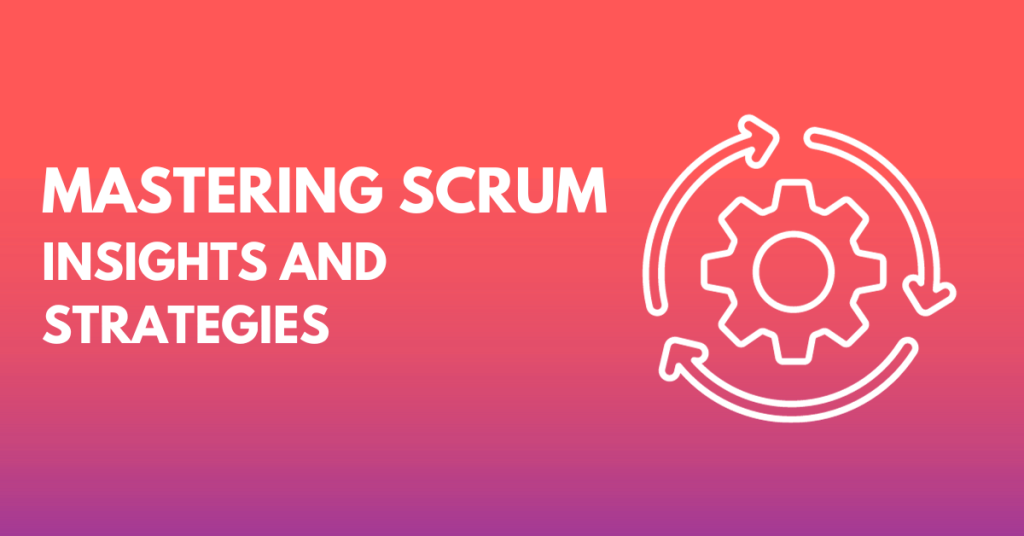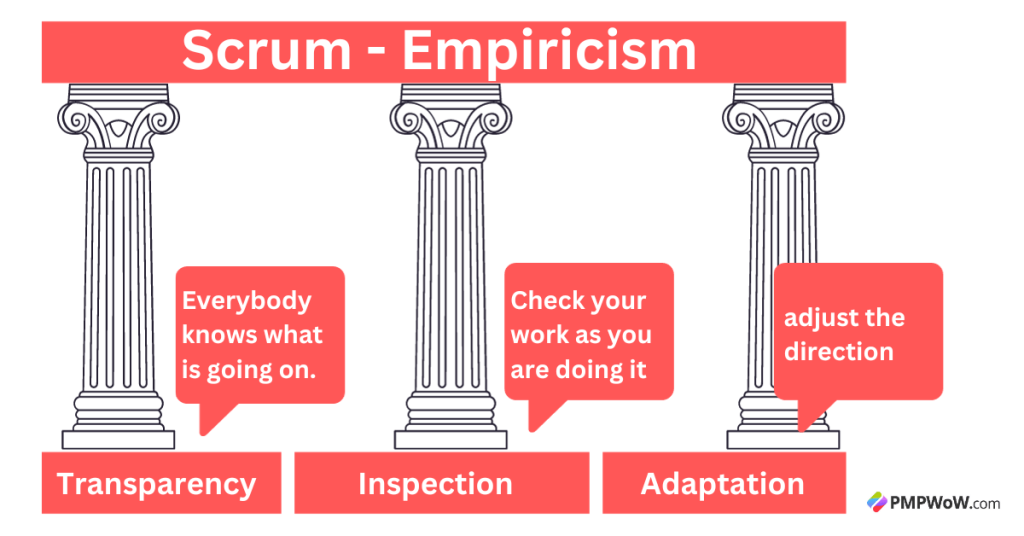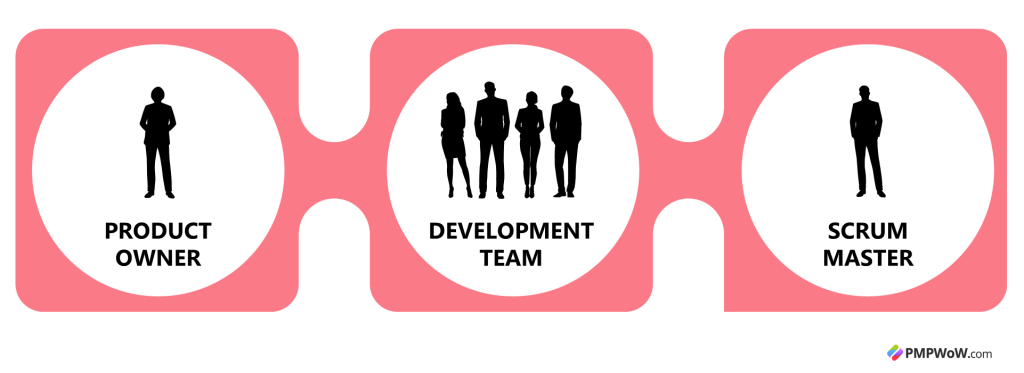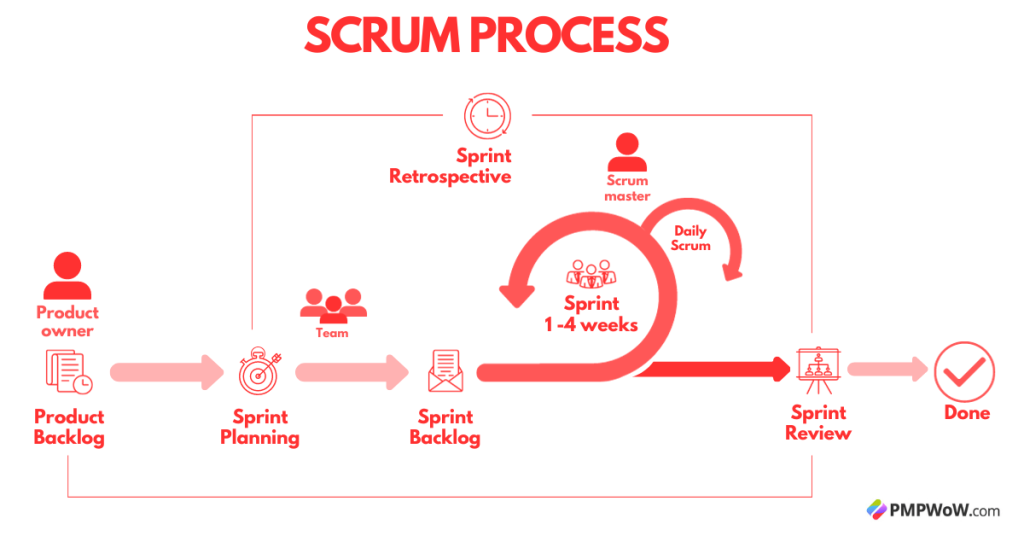
Mastering Scrum is a must-have technique for making a project successful. As a technical project manager, I’ve seen firsthand how Scrum can transform a project’s pathway. It’s not just about getting tasks done. It’s about doing them right with a team that’s in sync and a clear plan. Are you keen to get the inside scoop on Scrum? You’re in the right place with knowledge and practice that comes from real-world experience. Let’s continue to explore everything behind Scrum together!
The Core Principles of Scrum
In project management, Scrum stands out as a main feature for teams aiming for excellence. Drawing from my journey as a technical project manager, I’ve seen how mastering Scrum can elevate a project’s success rate. But what truly makes it a must?

- Empirical Process Control – Scrum thrives on Transparency, Inspection, and Adaptation. It’s about making informed decisions based on clear data and constant feedback. Those 3 factors mentioned in the above image are the foundational features must-have in a successful scrum.
- Self-Organization – Teams know their strengths. Scrum empowers teams to decide how best to accomplish their tasks, fostering ownership and commitment.
- Time-Boxing – Every activity in Scrum has a fixed duration. This ensures focus, urgency, and timely feedback.
- Value-Based Prioritization – It’s not about doing more; it’s about delivering value. Scrum emphasizes prioritizing tasks that offer the most value.
- Iterative Development – Instead of a one-shot approach, Scrum promotes breaking down tasks into smaller, manageable chunks, refining at every stage.
- Collaboration – Scrum is a team sport. It champions open communication, shared goals, and collective problem-solving.
Now, where does the Agile Manifesto fit in? The manifesto, emphasizing individuals, working solutions, customer collaboration, and adaptability, is truly expressed in Scrum. Every principle of Scrum is a nod to these values, making it a practical guide for teams aiming to embody Agile in their work.
For anyone keen on mastering Scrum, understanding these principles isn’t just beneficial; it’s essential. They’re the pillars that hold the Scrum framework together, guiding teams towards efficiency and excellence.
Roles and Responsibilities in Scrum
In the Scrum framework, success hinges on clear roles and responsibilities. As a technical project manager, I’ve seen how role clarity can make or break a project. Let’s dive into the three primary roles in Scrum and understand their significance.

Product Owner
- Visionary – The Product Owner has a clear vision of the product and communicates this vision to the team.
- Decision-Maker – They prioritize the product backlog items, ensuring the team works on tasks that bring the most value.
- Stakeholder Liaison – The Product Owner bridges the gap between the team and stakeholders, ensuring feedback flows and is acted upon.
Development Team
- Self-Organizing – The team decides how to meet the sprint goals, promoting ownership and commitment.
- Cross-Functional – The team has all the skills needed to deliver a potentially shippable product increment.
- Collaborative – Team members work together, sharing knowledge and skills to meet the sprint goals.
Scrum Master
- Guide – The Scrum Master ensures the team follows Scrum practices and principles.
- Problem Solver – They address any impediments the team faces, ensuring smooth progress.
- Coach – The Scrum Master helps the team improve, fostering a positive and productive environment.
Now, why is role clarity so crucial? In Scrum, each role has its unique responsibilities. The process runs smoothly when everyone knows their role and sticks to it. The Product Owner focuses on what needs to be done, the Scrum Master on how it’s done, and the Development Team on doing the work. This clear division ensures no overlap, confusion, or missed tasks.
Understanding these roles is very important for anyone aiming to master Scrum. They’re the pillars that support the Scrum framework, ensuring that projects are completed efficiently and effectively. Clear roles lead to clear results.
Advanced Scrum Artifacts and Their Significance
In the journey of mastering scrum, understanding its artifacts is essential. As a technical project manager, I’ve seen firsthand how these tools play a pivotal role in a project’s success. The main three advanced scrum artifacts are:
- Product Backlog
- Spring Backlog
- Product Increment
Product Backlog
This dynamic list contains every feature, function, and requirement that the final product needs. It’s not just a to-do list; it’s a strategic document that guides the team on what to work on next. As the project progresses, items in the Product Backlog may be updated or refined based on feedback and changing needs.
Sprint Backlog
Once the team decides what they want to work on during a Sprint, those items move to the Sprint Backlog. This list is more detailed and actionable. It breaks down the Product Backlog items into tasks. The team uses this as a guide during the Sprint to ensure they’re on track.
Product Increment
This is the tangible output of a Sprint. It’s a working piece of the product that adds to the previous versions. The goal is to have a potentially shippable Product Increment, meaning it’s high quality, meets the Definition of Done, and adds value to the product.
Over time, these artifacts evolve. As the team learns more about the product and gathers feedback, they make changes to ensure the final product meets the users’ needs. This adaptability is one of Scrum’s strengths. It allows teams to respond to changes quickly and efficiently.
These artifacts aren’t just lists or outputs; they’re tools that guide the Scrum team. They ensure everyone is aligned, knows their responsibilities, and works towards a common goal: delivering a high-quality product. Understanding them is key to truly mastering scrum.
Strategies for Effective Sprint Planning
Sprint planning stands out as a key phase in mastering scrum. As a technical project manager, I’ve observed that a well-executed sprint planning session can set the tone for the entire sprint. Here’s how to make it effective:
Clear Goals and Objectives
The team must understand the bigger picture before attending to tasks and user stories. What’s the main aim of this sprint? Maybe it’s to enhance a feature, fix critical bugs, or develop a new module. Having a clear goal ensures that everyone is on the same page and moves in the same direction.
Prioritizing Backlog Items
Not all backlog items are created equal. Some are crucial for the product’s next release, while others can wait. Here are some techniques to prioritize:
- Value to the User – Items that enhance user experience or solve a pressing user problem should take precedence.
- Technical Debt – Sometimes, addressing tech debt can speed up future development. If an item can reduce future work or risks, it’s worth considering.
- Dependencies – Some tasks depend on others. Identifying and prioritizing these can prevent bottlenecks later in the sprint.
Resource Allocation
Once you’ve prioritized, it’s time for resource allocation. Consider the strengths and weaknesses of your team members. Who’s best suited for each task? Also, ensure that no one is overloaded. A balanced workload often leads to better results and happier team members.
Yes! Sprint planning is more than just picking tasks for the next two weeks. It’s a strategic exercise that, when done right, can boost the team’s efficiency and the product’s quality. So, as you continue mastering scrum, give sprint planning the attention it deserves. It can make all the difference.
Mastering the Scrum Process
The Scrum process is a game-changer for teams aiming for agile project management. Generally, it is a 1-month (30-day) process. Here’s a quick rundown!

- Roles in Scrum – There are three main roles. The Product Owner manages the product backlog. The Scrum Master ensures the process runs smoothly. The Development Team works on the tasks.
- Sprints – These are short, time-boxed periods where specific tasks are completed. They usually last two to four weeks.
- Daily Stand-ups – These quick meetings help teams check-in. Everyone shares what they did, what they’ll do next, and any roadblocks.
- Review and Retrospective – At the end of a sprint, the team reviews the work and discusses what went well and what needs improvement.
- Product Backlog – This is a list of all tasks and features. It’s prioritized by the Product Owner.
- Sprint Backlog – From the product backlog, the team picks tasks to work on during the next sprint.
- Done – It’s crucial to define what “done” means. It ensures everyone has the same understanding and expectations.
By understanding and applying these elements, teams can make the most of the Scrum process and ensure projects run smoothly.
Overcoming Common Scrum Challenges
In the journey of mastering Scrum, teams often hit roadblocks. As a technical project manager, I’ve seen these challenges firsthand and have found ways to navigate them. Let’s discuss some common pitfalls and how to overcome them.
1. Resistance to Change: Humans are creatures of habit. When introduced to Scrum, some team members might resist the new approach.
- Solution: Start with small changes. Offer training sessions. Share success stories to show the benefits of Scrum.
2. Unclear Product Backlog: An unclear backlog can lead to confusion and wasted effort.
- Solution: Regularly refine the backlog. Make sure items are clear, actionable, and prioritized.
3. Overcommitting in Sprints: Packaging a sprint with tasks is tempting. But, overcommitting can lead to burnout and unfinished work.
- Solution: Be realistic. Use past sprints as a guide for what the team can achieve.
4. Neglecting Retrospectives: Teams might see retrospectives as unnecessary. But they’re crucial for continuous improvement.
- Solution: Make retrospectives engaging. Focus on solutions, not just problems.
5. Poor Communication: Scrum thrives on clear communication. Without it, the process breaks down.
- Solution: Foster an open environment. Encourage team members to speak up and share their thoughts.
While Scrum offers a robust framework for product development, it has challenges. But with the right strategies and a commitment to the process, teams can navigate these challenges and reap the benefits of Scrum. Remember, mastering Scrum is not just about knowing the framework but also about adapting and overcoming the hurdles along the way.
Continuous Improvement with Scrum Retrospectives
In mastering scrum, retrospectives stand out as a key tool. As a Technical Project Manager, I’ve seen how they shape a team’s growth. Let’s explore their role and some techniques to enhance their impact.
Retrospectives are the heartbeat of Scrum. They offer teams a moment to reflect, learn, and adapt. It’s where they identify what went well and what needs a tweak. The goal? Continuous improvement.
But how can we make these sessions count?
- Stay Open – Encourage honest feedback. It’s the foundation for real growth.
- Keep it Focused – Address specific events or issues. Avoid vague discussions.
- Action Items – End with clear steps. Knowing ‘what’s next’ is crucial.
- Rotate Facilitators – A fresh perspective can bring new insights.
Conclusion
Mastering Scrum is about embracing a mindset of continuous improvement and collaboration. As a technical project manager, I’ve witnessed the transformative power of Scrum in driving projects to success. Mastering Scrum is filled with challenges, but with the right strategies, insights, and commitment, these challenges become stepping stones to greater achievements. Remember, the essence of Scrum lies in its adaptability and focus on delivering value. So, as you continue mastering Scrum, always keep the core principles at heart, prioritize clear communication, and embrace the spirit of continuous learning and adaptation.








